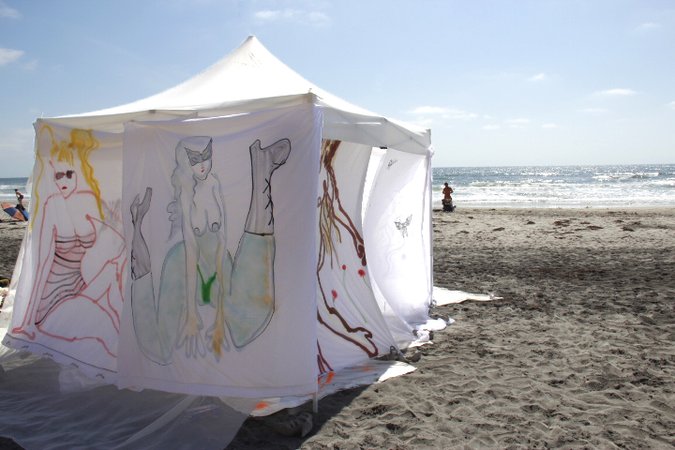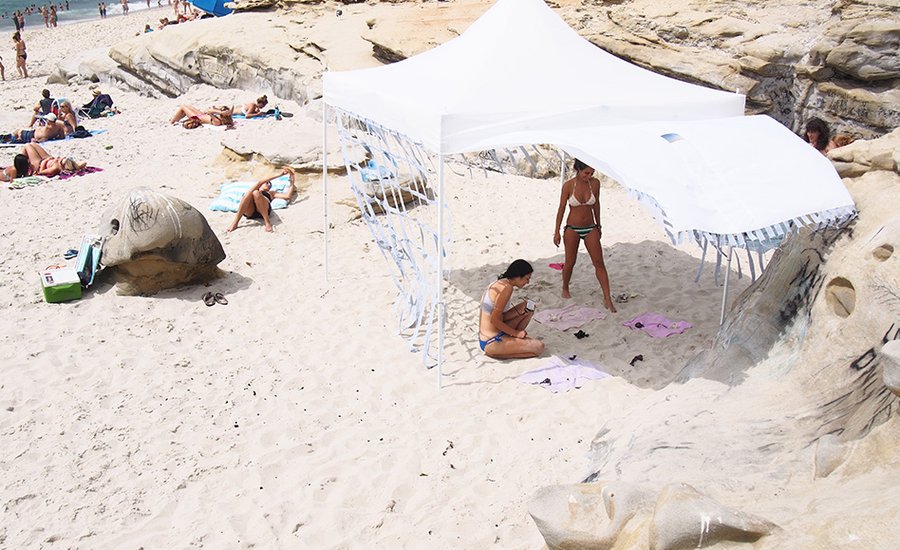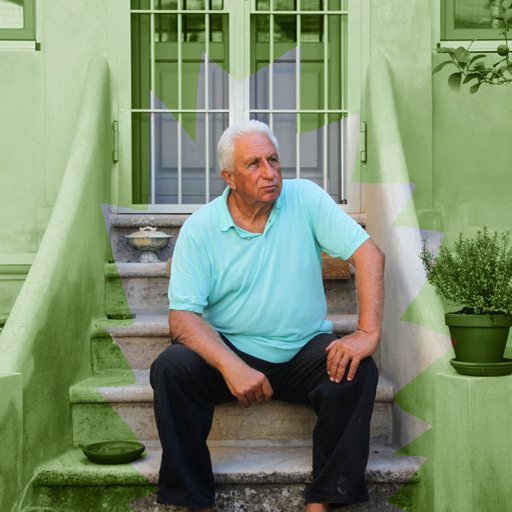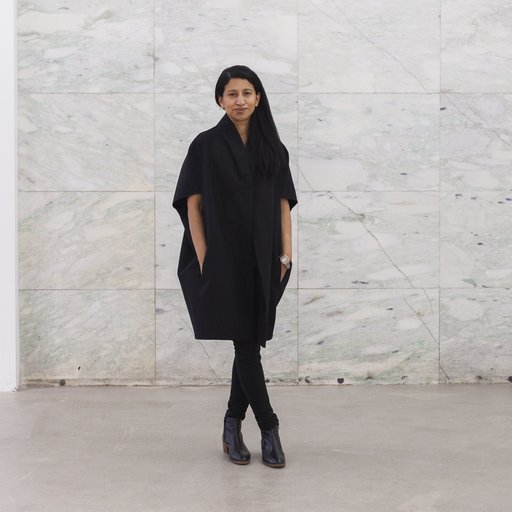Last week’s solstice made it official, summer is finally here—the time when heading to the beach on a weekend afternoon becomes something of a ritual. If you're on one of San Diego's many beaches one of those afternoons, you might be lucky enough to stumble upon a strange happening: a 10-by-10-foot white canopy surrounded by sculptures buried into the sand, and with painted swaths of fabric hanging from its steel frame, gently flapping from the sea breeze.
Artist Morgan Mandalay started SPF15, this coastal project space, in 2014, after moving from Chicago to San Diego to earn his MFA. Equipped with an offbeat idea, supportive group of friends, and $100, Mandalay started one of California's most unique project spaces. SPF15, while acting as a cheeky sunscreen pun, stands for S unday P roject F or 15 Exhibitions. This idea of a finite nature, of an ending in sight, has been at the core of Mandalay’s project since the beginning. Like the sand washed away by a high tide, SPF15 isn’t meant to hang around too long, and that’s part of the endeavor’s charm.
But for now, Mandalay is steadily riding the wave. SPF15 recently wrapped up show number 12, which was curated by LA-based artist Keith J. Varadi and featured work from Amy Yao , Keren Cytter , and Gene Beery. Over the years, SPF has featured an array of scorching hot artists, like Tanya Brodsky, Kara Joslyn , and Puppies Puppies (acting under the temporary moniker HorseshoeCrabs HorseshoeCrabs).
Below, Mandalay talks to Artspace's Robert Grand about his experiences in Chicago, his decision to start a gallery space on the San Diego shores, and SPF15’s goal to engage a diverse audience without acting to displace them—a challenge facing many art spaces in California and throughout the country.
 Installation view of "2) Audrey Hope, Allison Weise"
Installation view of "2) Audrey Hope, Allison Weise"
I wanted to start off by asking about the history of SPF15. It initially started as an apartment gallery in Chicago, correct?
Yes, well sort of. I would say that Sunday Project, the curatorial project in Chicago, was very much the genesis for SPF15. I guess you could say it evolved from that.
What was that experience like, running a space in Chicago?
For me it was really exciting. I had spent two years on a curatorial committee of a non-profit in San Diego before moving to Chicago. It was actually a pretty big space at the time. I was lucky to be one of the original members—I think the youngest too. Working with them was a great opportunity that taught me a lot about working with other artists. It also was my first experience dealing with organizing and conceptualizing exhibitions. Overall, I remember the experience very positively, but I remember the mission statement saying something about connecting artists and their surrounding communities. That would drive me nuts! The surrounding community of this space was mostly a homeless population, due to the majority of food banks and shelters in the city being concentrated around us. This was probably the first instance of me feeling really aware that this term "community" in the art world could be used as a red herring. It sounds good, but is pretty meaningless without some sort of qualifier.
So Sunday Project was an opportunity for me to spread my wings, so to speak. In many ways it was really rewarding. I learned a lot about what my own proclivities were, how I wanted to engage with other artists, how I thought about space in terms of creating narrative. But I also became really self aware of how spaces such as Sunday Project, small as it seemed, were playing a role in gentrification and displacement. Despite my good relationship with my neighbors, and despite my desire to think of art spaces as community spaces, it was clear that the community, my neighbors who had been in the Pilsen neighborhood for generations, had neither the need nor want for another exhibition space showcasing emerging artists.
Yeah, it’s a problem almost every art space has to wrestle with. I want to return to this, for sure, but to finish out the timeline—When you moved back to San Diego, to get your MFA from UCSD, did you plan to start a curatorial endeavor from the beginning?
Initially I thought I wouldn't. I had the idea for SPF15 but wasn't sure if I wanted to feel tied to the city again. I had previously lived in San Diego for almost five years. I guess I thought if I started a new project space, I wouldn't want to leave. At the time that seemed like a bad thing even though now I'm like, "Why would people ever want to leave San Diego?" [laughs]
Right before I left Chicago, I met Chelsea Culprit and Ben Foch. I mentioned this idea of a beach gallery to them and they were really encouraging. Then I came back for a visit and mentioned it to a few other people and talking about it got me really excited. People's responses were all really positive and made me feel like it wouldn't be interpreted as just some silly, jokey thing. So within maybe a month I had bought a tent for $100 and started scheduling shows.
 Installation shot from Chelsea Culprit: PAGAN SLUTz
Installation shot from Chelsea Culprit: PAGAN SLUTz
Yeah, it’s a really unique idea and comes from a really genuine place; I’m not surprised the response was positive. Why did you choose the beach for your gallery?
So when I started thinking about SPF15, I moved through a three-step process. First, I wanted to create a gallery that was affordable and sustainable. I'm working from a very modest budget and San Diego is pretty expensive. Second, I was working from this belief that a gallery should in some way reflect the culture, needs, and desires of the city it's in. By this I mean that galleries, while we've kind of accepted a semi-universal format, are things that pop up from specific urban needs based upon both the location itself and the inhabitants. So in a densely packed center, we’ll take NYC for instance, where it's hot and muggy in the summer and cold and snowy in the winter, it would make sense to have an indoor, air-conditioned space to exhibit work. Sticking with weather, San Diego doesn’t have any of those issues. It has a moderate climate the explores the many degrees of 70. San Diego is a city defined by its borders: to the south we have the busiest border crossing in the world, and to the west the beach serves as another kind of border. I have for a long time been interested in what can be learned about the government-ordained border by the natural border between land and sea.
We are also a city of public space and outdoor activities perhaps most often symbolized through surf and beach culture in general. That culture is a culture of looking and being looked at, so people on the beach are already primed for an aesthetic experience. Instead of body gawking, SPF15 aims to redirect this tendency towards works of art. Third, I wanted to open a space that engaged people who might not ordinarily go to art shows without disrupting housing communities, especially communities typically most impacted by poor artists looking to open up an art space. Again, this idea of public space and specifically public beaches becomes important to this end.
Choosing the beach as an exhibition venue seems very much in response to what you mentioned earlier, that galleries are often agents of gentrification.
Yeah, totally. This was a really important part of the project to me. When I had first started thinking about opening a space in San Diego, I began by thinking of spaces that seemed "un-gentrifi-able" or less "gentrifiable". The beach and the canyon trails were the two places my mind immediately went to. The beach had something more poetic about it. The rolling of the waves taking parts of the land back out to sea, while leaving some of itself behind. An ever-changing nature or a constant unbecoming. That nature of the beach served as a model.
I recognize that the topic of gentrification as it relates to art is extremely complicated. I don't want to sound myopic or in any way seem to be declaring a singular solution. This is just the one that's made me feel most comfortable. But even having the choice to not live in a major metropolitan area is one I realize many don't have. Space and how we use it is really my overall interest—be it taking up space in or out of a community, or space as movable as in a play, or space as illusionistic within a painting. In each, I am trying less to describe a definitive solution and more trying to explore complexities and make proposals for imagining space and our relationship to it.
Each show changes locations; in that way, no one beach becomes an art destination. I also try to have the tent itself utilized differently each time. It's been the fitting room for a film shoot, a temple on Mother's Day, a cookie stand, a play house, etc. There is no attempt to claim ownership over a space. The beach is public, and all shows are of course open to people to walk through. Some of the best conversations I've had are with people running up with a football under their arm on Fiesta Island, or nudist vacationers on Black's Beach, or stoners in Ocean Beach. Each beach has it's own unique culture which keeps things exciting. We even have had people get stuck on a four-wheeler once just outside of an exhibition. Wedding photos have become a kind of tradition to end the shows.
 A wedding photo shoot happening steps away from "Bahamas Bienniale presents HorseshoeCrabs HorseshoeCrabs"
A wedding photo shoot happening steps away from "Bahamas Bienniale presents HorseshoeCrabs HorseshoeCrabs"
Wow, yeah, definitely not your usual art audience. I love that the gallery acts as a setting for post-nuptial photos. Back to the nuts and bolts of the space, how do you go about figuring out programming?
I start from where anyone does: curiosity. I love working with artists whose work I maybe don't get but am drawn towards. I love getting to learn about other artist's practices. From there it's just a matter of what feels right. I try to have a healthy balance of artists outside of San Diego and in San Diego as it's important for me to showcase the really great work being done here that often goes under the radar. I also try to maintain a diverse programming that's reflective of the art world I've always known.
Now that you’re out of school, do you plan on sticking around San Diego and staging more SPF15 shows?
Yes, that's the plan. I'm really excited about the next couple of exhibitions, numbers 13 and 14. The first one is Anna Breininger, Jamie Felton, and Shanna Waddell followed by a show with work by Nevine Mahmoud, Chantal Wnuk, and John Zane Zappas. I'll have one more show and then SPF15 will take a new form with some changes I'm excited about. My partner Kim-Anh Schreiber will be joining me as a co-director. She's already shown work, written texts, done studio visits and helped with all sorts of things with SPF15 in the past so it just felt natural. We're working on ways to grow and change without losing sight of the project’s main goals and ethics.
We're also hoping to relaunch an alternative art "fair" we had organized in an old shopping mall a few years ago, called Date Night, with our partners Trevor Amery and Seth Ferris. There were no walls, and none of the invited galleries paid anything. All the spaces were also nomadic spaces. We have been really lucky and happy just to have such a great supportive community in this city. I mean, for sure, San Diego has its problems, I don't want to sound naïve here, but I suppose all cities do and it's about choosing which problems you want. I'm very into the kinds of freedom San Diego offers that I haven't found in other places.
 SPF15's booth at Date Night, featuring works by Catherine Czacki and Amy Reid
SPF15's booth at Date Night, featuring works by Catherine Czacki and Amy Reid
























